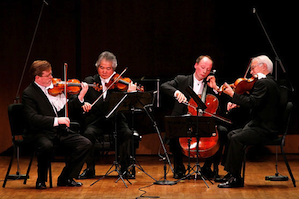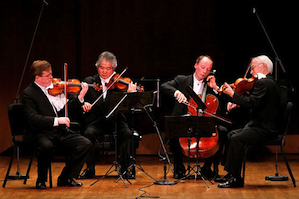
Some concerts attain historic significance even before they take place, and last Thursday’s concert by the Tokyo String Quartet, at San Francisco’s Herbst Theatre, was one of them.
After 44 years in the business, the Tokyo String Quartet is calling it quits. The esteemed ensemble has undergone several personnel changes over the years, but the imminent retirement of both founding member and violist Kazuhide Isomura and second violinist Kikuei Ikeda (who joined in 1974) was, it seems, a good moment to disband completely.
“We increasingly felt … that the most fitting way we could honor and celebrate our quartet’s long and illustrious career was to bring it to a graceful close,” first violinist (since 2002) Martin Beaver notes on the TSQ website. The concert at Herbst for Chamber Music San Francisco was part of the Quartet’s worldwide farewell tour, which ends in June.
The Quartet members perform on four rare and famous instruments with a long and detailed provenance that is most interesting and well-documented. The extremely abridged version is that all four instruments were built by Antonio Stradivari (between about 1680 and 1736), and at one point during the 19th century they were owned and played by Niccolò Paganini (1782–1840). The current owner of this “Paganini Quartet,” the Nippon Music Foundation, loaned the instruments in 1995 to the members of the Tokyo String Quartet, who have played them ever since. It is not yet known what will happen to the instruments after TSQ returns them.
Last Thursday’s concert program included Mozart’s Hoffmeister Quartet in D Major, K. 499; the Quartet in C Minor, Op. 51, No. 1, by Brahms; and a new piece, String Quartet No. 6, by Russian-American composer Lera Auerbach (b. 1973), which she subtitled Farewell when it became clear that TSQ would dissolve, but which had been commissioned earlier.
If it is true that the sound of a violin changes with its owner — and I don’t doubt that — then it must be doubly (or quadruply) true for the instruments that the members of TSQ play. These four Stradivari have not only been “exposed” to their respective players, but also to each other — and even more intensely so over the last two decades. It is almost impossible to imagine that they have not in some way influenced each other’s sound, thereby determining the superb, extremely versatile sound quality of the Quartet.
Lera Auerbach really knows how to squeeze different sounds out of a string quartet, and TSQ gladly obliges.
It is Lera Auerbach who places the heaviest demands on that versatility. Her writing ranges from “ugly” to “lyrical” and includes everything in between. She really knows how to squeeze different sounds out of a string quartet, and TSQ gladly obliges. Quite unlike its title, Farewell starts with stabbing chords that are nastier and more shrill than those that Bernard Hermann wrote for the famous shower scene in Hitchcock’s movie Psycho.
The piece evolves through a sequence that is best described as “variations on a theme and a few of its distant cousins”; there are all kinds of obvious and hidden relationships, yet everything is constantly changing — becoming increasingly more lovely, mysterious, and spacey.
Auerbach explores a wide range of emotions; packs huge, contrasting gestures into tiny musical spaces; opens up a completely new perspective every few notes; and ends her composition with the thinnest, softest note that cellist (and TSQ member since 2000) Clive Greensmith can play on his Strad.
For the Brahms quartet, which concluded the concert, TSQ seemed to have the bows strung with satin instead of horse hair.
During the concert, you could have heard a pin drop.
In the Mozart and Brahms quartets, where contrast is measured on a different scale, TSQ employed other extremes: emphasizing the pulse in the Mozart quartet’s first movement, contrasting it with the flamboyant second movement and the intense and gripping third movement (Adagio), where Mozart shows his most dramatic side. After that, the final Molto allegro came as a relief; it was the cherry on top.
For the Brahms quartet, which concluded the concert, TSQ seemed to have the bows strung with satin instead of horse hair. But here, too, the players intensified and deepened every delicious twist and turn, taking the listeners through one musical painting after another.
And after all this density from Brahms, there was a little bit of levity from Papa Haydn in the virtuosic encore, leaving the listeners in awe and surely feeling honored and privileged to be in the presence of such great art.

